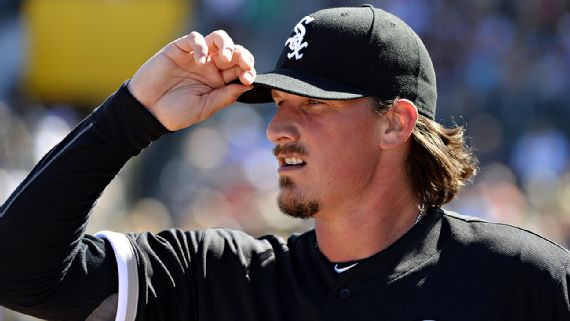Samardzija isn't the pitcher the Giants are paying him to be (ESPN)
|
One would think that a smart, competitive baseball team wouldn't want to spend almost $100 million on a 31 year-old pitcher who just led the major leagues in earned runs and hits allowed. And yet, that is what the San Francisco Giants just did by inking Jeff Samardzija to a five-year, $90 million deal.
The question isn't how much stock you put in Samardzija's fluky 2015, a bad year exacerbated by terrible luck. The question is how much faith do you put in a guy on the wrong side of 30 who had one All-Star season sandwiched between two horrendous ones?
Because $90 million is a huge investment in a pitcher who's yet to demonstrate any sort of consistency beyond his ability to top 200 innings repeatedly -- something he's done three straight years now. Despite his advanced age, Samardzija's been a full-time starter only four years, during which time his results have varied wildly. He was good in 2012, bad in 2013, great in 2014, and terrible last year. His career has been a rollercoaster ride in the same vein as Clay Buchholz's, minus the injuries.
Who is the real Jeff Samardzija, then? Probably somewhere in between, but definitely in decline. His strikeout rate has dropped every year since 2012, from a stellar 9.27 K/9 to last year's mediocre 6.9 K/9. He's lost nearly a mile off his average fastball during this time, which explains why batter pull rates have increased against him the last two years along with those sinking whiff rates. Hitters aren't just making more contact against him--they're having an easier time turning on his stuff.
Samardzija seemed to be compensating for this drop in velocity by becoming more of a sinkerballer, as his ground ball rates improved steadily from 2010 through 2014. Last year was a reversal of this trend, however, as he posted his lowest grounder rate since 2010--a direct result of leaving too many pitches up in the zone (hence all the homers). A return to form requires that he gets back to keeping the ball down, lest he continue surrendering big flies at a prodigious rate.
Moving back to the National League and trading Chicago's launching pad for San Francisco's pitcher's heaven will help, as will regression to the mean. But Samardzija's never going to be the pitcher he was two years ago unless his strikeout rate returns -- a longshot given his plummeting velocity. At best, he projects to be a mid-rotation arm, while at worst he's a back-of-the-rotation filler making boatloads of money.
The Giants know better than anyone what it's like to be stuck with a bad, expensive, healthy starting pitcher--i.e. Barry Zito, Tim Lincecum, and now Matt Cain--which makes this deal all the more confusing. Obviously they expect him to bounce back, which I think he will to some degree, but they were probably just as motivated by their disappointing 2015 campaign and subsequent failure to land Zack Greinke.
The Giants know better than anyone what it's like to be stuck with a bad, expensive, healthy starting pitcher--i.e. Barry Zito, Tim Lincecum, and now Matt Cain--which makes this deal all the more confusing. Obviously they expect him to bounce back, which I think he will to some degree, but they were probably just as motivated by their disappointing 2015 campaign and subsequent failure to land Zack Greinke.
I just don't see this deal working out for San Francisco. I think it's going to end up like the Lincecum extension, which everyone knew was a mistake at the time and, sure enough, proved to be a huge waste of money. Except this deal is even worse, because the Giants are on the hook for more years and dollars with an older, less established pitcher who's on his fourth team in three years (never mind the fact that Samardzija was never as good for as long as Lincecum--a two-time Cy Young winner).
As with Lincecum, Brian Sabean is overestimating Samardzija's ability to rebound from a bad season and not seeing the forest for the trees. He's paying Shark to be the pitcher he used to be, not the pitcher he is or will be.

No comments:
Post a Comment